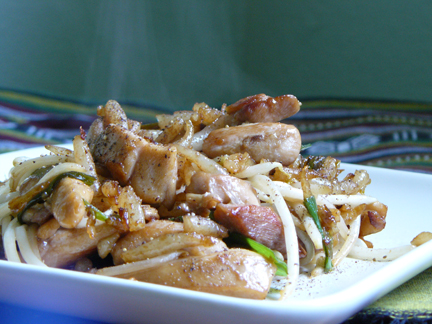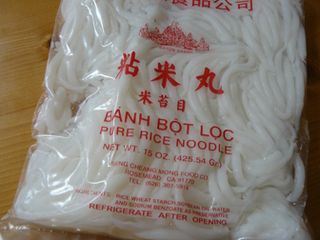A few days ago, I reviewed Corinne Trang’s new book, Noodles Every Day, and discussed how it helped me to resolve a culinary mystery regarding a type of fresh Asian rice noodle called mouse tails. From the comments and discussion that ensued, I realized that the term ‘mouse tail noodle’ is commonly used in Malaysia, as my friend Annie pointed out. The actual Chinese characters, 老鼠粉, lo shu fun in Cantonese, literally translates to old mouse/rat tail! I’m going with the more poetic name of silver pin noodles from here on in as it’s definitely a better sell.
I purchased my silver pin noodles from Lion Foods market in San Jose, California. They were located in the refrigerated section near the other fresh noodles and tofu. The package is below:
Fresh from the store, the noodles were somewhat soft, but they hardened under cold refrigeration. When I went to cook the silver pin noodles in Corinne’s recipe, I gently broke up the noodles, which were stuck together in one thick layer. Some of the tapered ends broke but that’s a small price to pay. And for good measure, I rinsed the noodles under warm water to remove some of the chill. You won’t have to bother with any of this if your noodles are fresh. Here are some nice ones, which are traditionally hand-rolled but I fathom that that's not the case anymore:
A well-seasoned cookbook writer, Corinne advises readers to stir-fry the noodles in 3 separate batches so as to not crowd the wok. That was a great suggestion as it also allowed me to tweak the recipe to my own preferences as I progressed. I mis-en-place everything so that I could whip through each batch in an assembly-line fashion just like Corinne’s uncle did for her family; the recipe headnote (the introduction) relays his actions. The process enabled me to work through the recipe thrice. Here are my reports:
Tasty and rich, but a little oily and salty. The silver pin noodles stuck to my carbon-steel wok. I have bad luck with stir-frying noodles in the wok, though it’s well-seasoned. Unless the noodles are very dry, they always stick. I was skeptical about having to cook the noodles for 5 minutes but my timer proved me wrong. It did take a while for the silver pin noodles to soften. When done, I didn’t like keeping the boneless thighs whole as they didn’t mix in with the noodles. My preference is to get a piece of chicken in each forkful of noodle. (I learned from the Malaysians that it’s best to eat these stubby slippery noodles with fork and spoon.)
Trial 2: Nonstick skillet, cutting up the chicken
Using the 12-inch nonstick skillet allowed me to use a little less oil. My Pearl River Bridge soy sauce is likely to be saltier than what Corinne used to develop the recipe so I decreased the soy. I cut the chicken into ½-inch wide strips. I sprinkled some soy sauce on the chicken to see if that generated extra flavor, but cooked it for too long and it dried out and wasn’t as succulent as the first time.
Trial 3: Nonstick skillet, cutting up the chicken, less cooking time
Got it the way I liked it. Lightly greasy in a good way, salty, and juicy chicken; I didn’t sprinkle on any soy before cooking. I went light on the black pepper the first two tries and on the last try, gave it a generous ⅛ teaspoon of freshly ground Vietnamese Phu Quoc pepper, a food souvenir from my 2008 trip to Saigon.
All three times, the dish tasted great. My husband and I ate them all up. We’re piggish. Corinne’s recipe provided the guiding principles and instructions. I initially followed them exactly to get a sense of her direction and flavor palate, and when I understood them, I adjusted things to suit my tastes. Below is the silver pin noodles recipe for you to try.
RECIPE
Silver Pin Noodles with Chicken, Bean Sprouts, and Scallions
Serves 6
6 tablespoons vegetable oil
3 scallion, trimmed, quartered lengthwise, and cut into 1-inch-long pieces
6 boneless skinless chicken thighs
1 pound fresh silver pin noodles
1 ½ cups mung bean sprouts
6 tablespoons thin soy sauce
Fresh ground black pepper
Heat 2 tablespoons of oil in a wok over high heat, and stir-fry a third of the scallions until wilted, about 1 minute. Add a third of the chicken and continue to stir-fry until cooked through, about 2 minutes. Add a third of the noodles and continue to stir-fry until the noodles are heated through and softened, about 5 minutes. Add ½ cup of the mung bean sprouts, 2 tablespoons of the soy sauce, and season with pepper to taste. Toss, cook for 1 minute, divide into 2 servings, and serve hot. Repeat twice more, splitting each batch into 2 servings.
From Noodles Every Day: Delicious Asian Recipes from Ramen to Rice Sticks by Corinne Trang (Chronicle Books, 2009)
If you have tips on silver pin noodles, successfully stir-frying noodles in a wok, or have tried this recipe from Corinne's book, please share your experience!




















Neal Belanger says
Our favorite Vietnamese restaurant here in Philadelphia (Nam Phuong) offers "Needle Noodles with Shrimp." They are wonderful. Noodles appear to be the same.
Andrea Nguyen says
Neal, that's the first time I've heard of a Vietnamese restaurant offering silver pin noodles on the menu. Vietnamese markets usually don't carry the noodles among the fresh noodle offerings so maybe we're on the cusp of something? Or, perhaps the folks at your Philly Vietnamese restaurant are Chinese-Vietnamese?
Thanks for the insights!
Condimentality says
These noodles are a specialty of Taitung (台東) Taiwan. I had them in a clear soup with mung bean sprouts, "A" vegetable (A菜), and freshly shaved bonito. I also had them stir fried in chili oil with wontons. The soup was especially interesting, since they contrasted well with the bean sprouts (though they look almost identical). They are tricky to eat, though.
Andrea Nguyen says
Condimentality (love the name!) -- How interesting. I was wondering if these noodles were added to soup broth. All the preparations I've seen are for stir-fried dishes. I know what you mean about the bean sprouts and noodles looking the same but texturally contrasting. It's such a 'clever' approach.
Forgive me for asking but what is A cai/vegetable? Or is that a generic term for a green vegetable.
Condimentality says
A cai (I don't know of any English translations of the name) is a popular Taiwanese vegetable that's similar to romaine lettuce. It's commonly stir fried or put in soup.
From what I understand, it's called "A" vegetable because the name for it in Taiwanese sounds like the English letter "A".
Andrea Nguyen says
Okay, I'll look for that. Wonder if it's Celtuce.. but I don't think so:
http://en.wikipedia.org/wiki/Celtuce
thuy says
I just tried the recipe... delish!!!
chris says
Hey Andrea!
We definitely eat them with soup in Singapore - good fishball noodle stalls will offer them as an option among the more usual kinds of noodles.
In Malaysia they are often cooked claypot-style - eg http://eatthewalk.blogspot.com/2005/12/restaurant-seng-kee-kuala-lumpur.html
And in the army we often get them as breakfast, stir-fried with chilli, garlic, soy sauce, egg and a few shreds of greenery.
Quynh says
Great recipe. I live in Toronto. I found a similar noodles, made in Canada labled Rice Noodles but when looking at the ingredient list it has potato start, corn starch, rice and etc.. By the way what do you think about boric acid being used oversea as additive? (han the)
Andrea Nguyen says
Boric acid makes food crunchy/firm and I feel that there are other ways to get that texture. Thing is that too many people over use it and that's not bad. It's toxic stuff and the USDA doesn't allow it above a certain level.
Ajf 4 says
I do not like work ---no man does --but I like what is in the work -----the chance to find your self. (Conrad Joseph, British novelist)
Creative Recreation says
You got a really useful blog I have been here reading for about half an hour. I am a newbie and your post is valuable for me. these practices are unfair; but they say that most of their rules are only to apply to people who overdra.
air jordan 2 says
After reading the you nice article. Dear friends, I have just one word to say right now,you are so brilliant. You have a good personality. Good job you do. WISH YOU HAPPY EVERY TIME.
Supra TK Society says
Patience and application will carry us through.
billy says
I went to the Viet market here in Chicago and recognized these noodles from this recipe. I had these noodles on a trip to HK one time and it was awesome. I can't wait to try it out!
Btw, what's up with all these sneakers ad spam from random commentators?
oakley sunglasses says
!!#Little else is known about the genus, though, save their elusive desirability amongst maniacs of high monkey type image.
125_+
oakley sunglasses says
87*/*There are thankfully no monkeys on Pulau Hantu. ideas for Shayna, leave a comment! ''&
Canada Goose Danmark says
Nor are the insights of happiness limited to what is near around you.
Beats by Dr Dre says
If we can only encounter each other rather than stay with each other,then I wish we had never encountered.
Jamie says
Khmer people has a variation called "Lot Cha" The pin noodle in the picture above is from a khmer based business in California. Haven't seen any other brand in the States.
marlon says
You got a really useful blog I have been here reading for about half an hour.